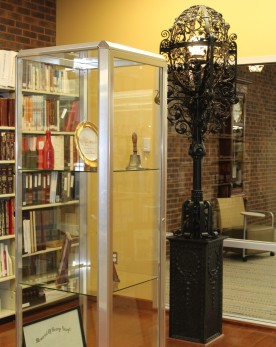This is an updated reprint of a “From the Local History Room” column that first appeared in January 2014 before the launch of this weblog.
Do you know the way to Bean Town?
By Jared Olar
Library assistant
The city of Pekin has seen vast changes since its birth as a pioneer town in 1830 and its incorporation as a city in 1849. Old maps and atlases show the city’s growth, as it spread out to the east, south and north from the original town (now the old downtown area of Pekin) and new sections and streets were laid out.
The maps give the names of the new subdivisions – Cincinnati Addition, Broadway Addition, Colts Addition, Leonard Addition, Edds Addition, Casey’s Addition, etc. However, there is one part of Pekin that had a unique name which does not appear on the old maps, because it wasn’t an “official” name.
That section was popularly known as “Bean Town.” It was the old northeast quarter of Pekin, bounded on the south by Broadway and on the north by Willow, with George Street (today called Eighth Street) as its western boundary. In the days when “Bean Town” got its name, the neighborhoods north of Willow and east of 14th Street did not yet exist.

Shown is a detail from the map of Pekin found in the 1873 “Atlas Map of Tazewell County.” The northeast quarter of Pekin, indicated by the box, and areas adjacent to it were heavily settled by German immigrants beginning about the mid-1800s. Because the Germans living there usually maintained gardens in which they grew beans, the quarter came to be known as “Bean Town” (“Bohnen Fertel”).
Why was Pekin’s old northeast quarter called “Bean Town”? It got its name as a result of the very great numbers of German immigrants who arrived in Pekin during the middle and latter half of the 1800s. “Bean Town” was Pekin’s German quarter. It was in that quarter, at 1100 Hamilton St., where the parents of U.S Senator Everett M. Dirksen lived, and where Dirsken and his twin brother Thomas lived as children.
“An indication of the heavy immigration could be seen when there was an ice jam in the river at Cairo in January of 1854. It held up 14 steam boats loaded with some 2,000 German immigrants,” says the 1949 Pekin Centenary on page 15.
Continuing, the Centenary says, “The Germans built neat homes, and were enthusiastic gardeners. They located in large numbers in the northeast part of Pekin. Their gardens gave that part of the city a character all its own, and it came to be called ‘Bohnen Fertel’ in German, later called ‘Bean Town’, for the same reason; and with the passage of years ‘Bohnen Fertel’ became corrupted into Bonshe-fiddle.
“Though the gardens are long since gone, Pekinites still refer to ‘bonshe-fiddle’ and ‘bean town’ in speaking of that part of the city.”
As the Centenary says, “Bohnen” is the German word for “beans.” The word “Fertel” is an old variant form of the German word “viertel,” meaning a fourth or a quarter. (“Fertl” also means “quarter” in Yiddish.) Because the German immigrants liked to plant their gardens with beans, the neighborhood came to be called Bean Town.
For a while in the latter 1800s, the majority of Pekin residents were German, and the German language could be heard here almost as commonly as English. With World War I, however, came a reaction against all things German. As a result, the children of German immigrants hastened to assimilate into American culture, and Pekin businesses began to take down their “Wir sprechen hier Deutsch” signs.
The name “Bohnen Fertel” or “Bean Town” has long since fallen into disuse. The only visible trace of that place-name today is in the name of Bean Town Antiques, a former market at the corner of 14th and Catherine streets.



